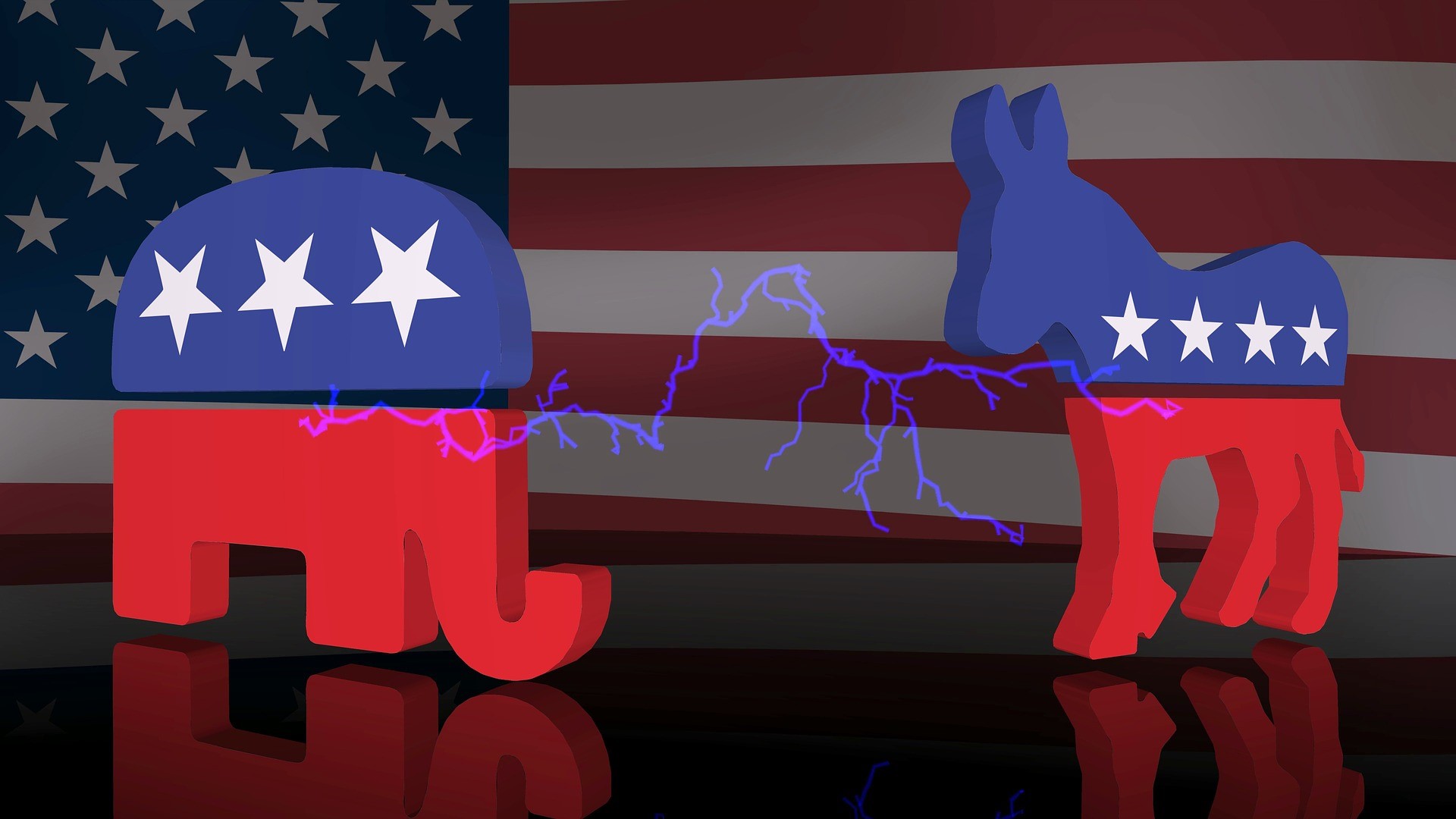BlueBay AM: Blue wave, second wave: surf’s up, ride on…
BlueBay AM: Blue wave, second wave: surf’s up, ride on…

By Mark Dowding, CIO at BlueBay Asset Management
Coronavirus and the US election look set to remain front and centre over the near term. While the outcome on either is far from decided, on the latter at least, polls suggest that a blue swell is coming. Yet, unusually, it doesn’t seem to be making too many waves when it comes to risk appetite – at least for now.
In the wake of a tumultuous week with respect to US politics and Donald Trump’s presidency, the latest polls appear to suggest John Biden pulling decisively ahead in the race for the White House.
With a number of Senate races also looking too close to call, this has seen markets assign an implied probability of around 60% to a Democrat clean sweep, also opening the possibility that the Democrats could win sufficient seats to overturn the filibuster, which could see far more wide-ranging political change in the coming administration.
That said, plenty can still happen between now and 3 November, and it is worth remembering that Trump was also trailing Hilary by double digits in the polls at this point in 2016. However, momentum seems to be heading the wrong way for the Republic Party right now and it could be that the race is now down to Biden to lose.
Consequently, it may seem likely that the Democrats will want to wrap him in cotton wool and keep him as quiet as possible without needing to engage with the ‘tweeter in chief’ at this particular juncture.
Riding Dem waves
Notwithstanding the political backdrop, financial assets have been relatively calm during the past week, even while Trump was hospitalised. It appears as if investors are now starting to look beyond the election towards a vaccine and a more positive growth trajectory in 2021, with central banks continuing their ultra-accommodative monetary policies on a global basis.
Ordinarily, the threat of a Democratic ‘blue wave’ might weigh on risk appetite, but we don’t feel this is evident in 2020. When Trump was elected in 2016, it is estimated that the implied policy shift relative to Obama lifted stocks by approximately 10% thanks to the promise of lower taxes.
Consequently, the threat of higher taxes under Biden might usually be extrapolated to suggest a 10% reversal; however, in the shorter to intermediate term, the fear of higher taxes to come is being offset by the promise of higher government spending in the year ahead.
Were Democrats to score a resounding victory, we could envision a Biden administration overseeing a USD5 trillion fiscal package of measures, dwarfing the current ask of USD2.2 trillion, which Republicans are unwilling to agree to.
This is a huge sum (for comparison, US GDP is USD20 trillion) and, consequently, it may be understandable if markets look through the disappointment at the current political impasse, in the knowledge that further fiscal spending is not far around the corner.
In the meantime, economic data is holding up well enough. Although a ‘second wave’ of Covid-19 infections continues to build and further restrictions are being announced in the wake of this, we are yet to see this lead to a deterioration in sentiment in the US.
Therefore, even as both the blue wave and the second wave appear to build, markets seem happy to take this in their stride for the time being and risk assets have enjoyed a positive start to the fourth quarter.
A SURE thing
Newsflow in Europe has been relatively quiet during the past week. Despite the threat of some hold-up in the ratification of the EU fiscal initiative, this is SURE (!) to pass in our view and any delay is unlikely to impact the deployment of funds.
Service sector purchasing managers’ index surveys saw a material dip in Spain and France in the wake of additional lockdown measures. Despite this, sovereign spreads continued to grind tighter on hopes that the European Central Bank (ECB) will announce further easing before the end of the year, which will see it add to its asset purchase programme.
We believe there is a risk that these hopes are disappointed and, with yields across the eurozone at their lows (the Euro Aggregate Index of all Investment Grade Euro sovereign, corporate and securitised bonds fell below 0.0% this week), we could imagine the ECB happy to defer a decision on additional stimulus into 2021.
On this basis, we feel that Bund yields are unlikely to fall much further for the time being. European yields have outperformed, even as Treasury yields have risen during the past week. Having previously favoured European versus US duration, we believe that if US yields rise further then this will weigh on Bunds.
With respect to US Treasuries, we doubt that the Federal Reserve (Fed) will allow yields to rise very much, particularly given the likely absence of further fiscal support before the election takes place.
Should asset allocators switch away from Treasuries and fixed income in general, it is conceivable that 10-year notes could rise to 1.0%. That said, low inflation, abundant liquidity and a dovish Fed could just as easily see yields head back toward 0.60% in our view.
Reflation trades may be the theme in 2021, but it may still be a little premature to turn bearish on long-dated rates. However, given we believe that Bunds are not likely to rally further, we can see an asymmetric return profile with respect to European rates and have initiated a short-duration trade with a relatively short-term investment time horizon that seeks to capture this.
Understanding and exchange
Meanwhile, Brexit negotiations remain an ongoing focus in the UK. While headlines are being traded back and forth, our underlying assessment is that there is a desire to conclude a deal in principal very soon and we are hopeful that compromise on both sides will enable this framework to fall into place as soon as the end of next week.
Elsewhere, robust risk appetite has seen a rally in emerging-market assets and currencies in the past several days. Relative strength in China is supporting sentiment in Asian assets and also underpinning commodity prices, helping resource-dependent economies.
We retain a positive stance with respect to the Chinese renminbi, Mexican peso and Russian rouble versus the US dollar, as well as running a long position in sterling and the Norwegian krone versus the euro.
At a time when we believe that moves in core rates markets may be quite limited, divergent policies and economic performance appear to be creating a backdrop with increasing opportunity from moves in relative exchange rates in the current investment environment.
Rallying spreads
Corporate bond spreads have also rallied at the start of October. High-yield spreads were under some pressure during September, leading index spreads to widen by 50 basis points (bps). However, this move has now been fully reversed, with levels back to where they sat at the end of August.
Investment-grade spreads have been much more stable, with European corporate bonds outperforming, helped by purchases under the ECB’s corporate sector purchase programme and a moderating supply outlook. Consequently, European investment-grade spreads are now at their tights since markets sold off in the wake of Covid-19 in March.
Since the end of 2019, spreads in high yield have now widened by approximately 130bps, compared to 25bps in investment grade. By contrast, an index of bank CoCo debt is 150bps wider. At current valuations, we don’t see too much value in high-quality credit, with issuers that the ECB is purchasing trading at very tight levels.
We are also cautious where we invest in higher-yielding securities, as we expect default rates to remain elevated for the next 12–18 months on the back of the fallout from the Covid-19 recession.
However, in areas such as bank CoCos, corporate hybrids and other parts of the credit market, we continue to see pockets of value and believe that spreads should continue to rally on prospects for an improving outlook in 2021.
Pièce de resistance
Looking ahead, it would seem that the US elections and the coronavirus will continue to provide the focus of attention for markets in the month ahead.
We had wondered if risk appetite would be supressed in the run-up to the vote, given the uncertainty this could generate. Yet, the price action in the past week may be quite instructive.
In many respects, the hospitalisation of Trump and prospects for a blue wave could have created a catalyst for a reversal in risk sentiment, but this has not come to pass. With cash on the sidelines and investors looking to buy the dip, it seems that markets have been able to climb the ‘wall of worry’. Waves may be building but (for now) the surf’s up and it’s time to ride on.
Increasingly it seems that this POTUS may not matter very much anymore. To the ‘Donald’, this realisation may prove to be even more difficult to deal with than the experience of contracting the coronavirus itself.





